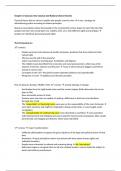Samenvatting
Samenvatting/summary Advanced Criminology (book+article+lectures)
Dit is een samenvatting van het boek 'Essential criminology', en het artikel 'From “We Didn’t Do It” to “We’ve Learned Our Lesson”: Development of a Typology of Neutralizations of Corporate Crime'. In de samenvatting zitten ook mijn aantekeningen van de colleges verwerkt. This is a s...
[Meer zien]














